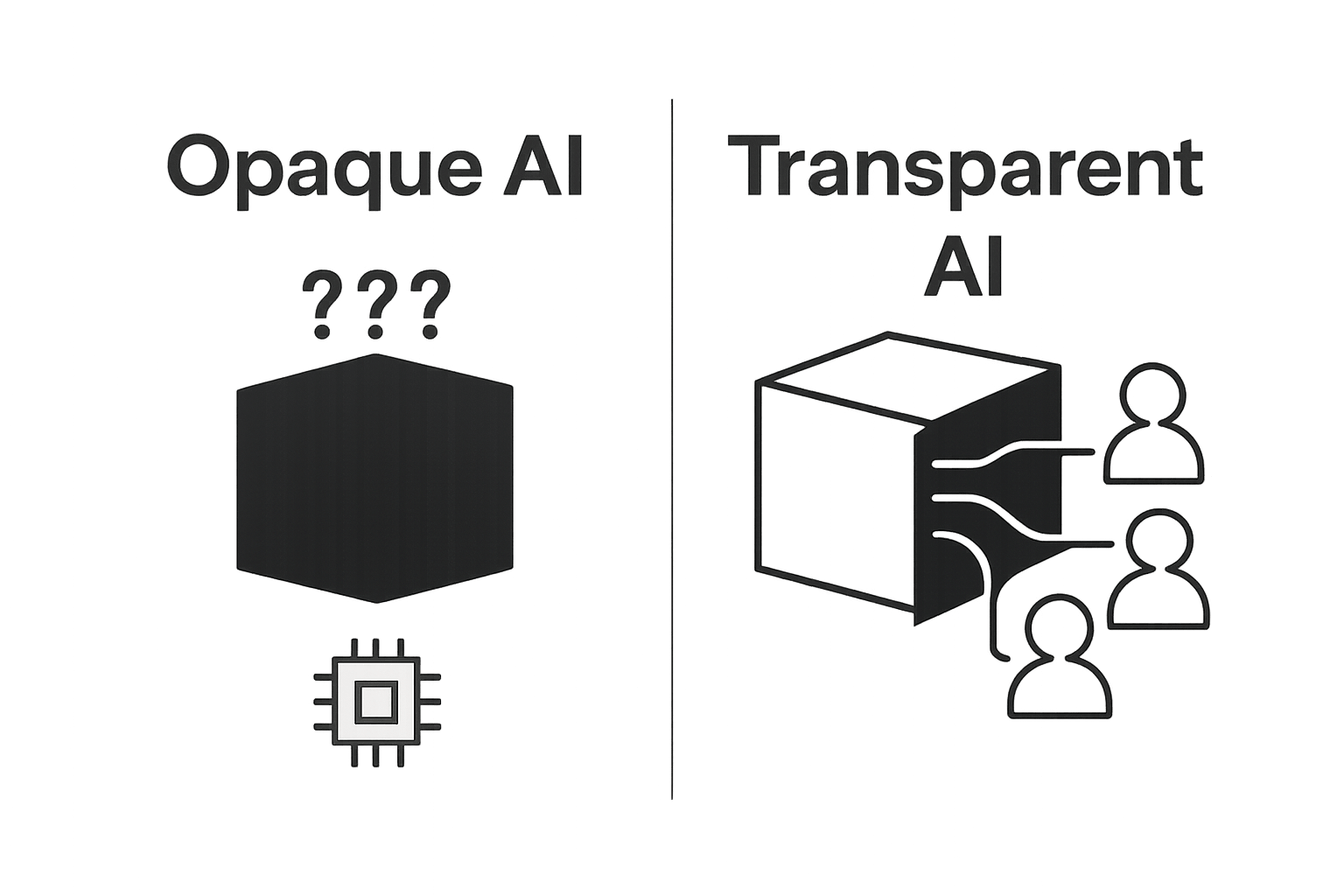What is AI Transparency? Understanding Its Importance

AI transparency is on every business leader’s mind as companies look for smarter, safer tech solutions and tighter controls over digital decisions. But most people picture transparency as a stack of technical paperwork or confusing data dumps. The surprise is that companies with transparent AI see up to 25 percent stronger stakeholder trust compared to those with black box systems. Clarity is not just about rules and compliance, it is quickly becoming the new currency for competitive advantage.
Table of Contents
- Defining AI Transparency: What It Really Means
- The Importance of AI Transparency in Business Contexts
- How AI Transparency Works: Mechanisms and Principles
- Key Concepts in AI Transparency: Ethical Considerations
- Real-World Applications of AI Transparency in Business
Quick Summary
| Takeaway | Explanation |
|---|---|
| AI transparency is critical for organizations | Understanding AI decisions helps mitigate risks and fosters trust among stakeholders. |
| Transparent AI enhances competitive advantage | Clear communication of AI capabilities builds stronger relationships with customers and partners. |
| Implement ethical guidelines in AI design | Fair and accountable systems prevent discrimination and ensure responsible technology use. |
| Regular audits ensure ongoing transparency | Continuous evaluation of AI systems identifies biases and maintains public trust. |
| AI should support human decision making | Empowering humans with AI insights prevents over-reliance on technology and promotes informed choices. |
Defining AI Transparency: What It Really Means
AI transparency represents the fundamental principle of making artificial intelligence systems comprehensible, accountable, and interpretable for humans. At its core, transparency means revealing how AI arrives at specific decisions, what data it uses, and the potential biases or limitations inherent in its processing. Understanding AI decision making goes beyond mere technical disclosure.
The Core Components of AI Transparency
Transparency in AI involves several critical elements that help stakeholders understand and trust technological systems.

These components include:
- Algorithmic Disclosure: Revealing the fundamental logic and computational processes behind AI decision making
- Data Source Clarity: Identifying the origins, types, and potential biases within training datasets
- Performance Metrics: Providing clear information about system accuracy, error rates, and predictive capabilities
Business leaders recognize that true AI transparency means more than technical documentation. It requires creating systems where human oversight remains central. At Average Robot, we believe AI should empower human decision making, not replace critical thinking. Our strategic approach to AI implementation emphasizes keeping humans firmly in control.
Why Transparency Matters for Organizations
For businesses adopting AI technologies, transparency is not optional but essential. Organizations need to understand how AI systems reach conclusions, especially when those decisions impact critical business operations, customer experiences, or strategic planning. Transparent AI ensures ethical use, reduces potential risks, and builds trust among stakeholders.
By demystifying AI processes and maintaining clear communication about technological capabilities and limitations, businesses can transform complex technological tools into strategic assets that drive meaningful growth and innovation. The goal is not just implementing AI, but implementing AI responsibly and intelligently.
Transparency ultimately bridges the gap between technological potential and human understanding, creating systems that are not just powerful, but also trustworthy and aligned with organizational values.
To clarify the foundational aspects of AI transparency, the following table outlines its core components and what each means for organizations:
| Component | Description |
|---|---|
| Algorithmic Disclosure | Revealing the underlying logic and computational steps behind AI decision making |
| Data Source Clarity | Identifying origins, types, and potential biases within datasets used to train AI |
| Performance Metrics | Communicating accuracy, error rates, and predictive capabilities of AI systems |
| Human Oversight | Ensuring humans remain central in monitoring and guiding AI decision processes |
| Documentation | Keeping comprehensive technical and operational records of AI system behaviors and modifications |
The Importance of AI Transparency in Business Contexts
In the rapidly evolving landscape of business technology, AI transparency has transitioned from a theoretical concept to a critical strategic imperative. Organizations are increasingly recognizing that the true value of artificial intelligence lies not just in its computational power, but in its ability to provide clear, understandable insights that enable informed decision making. Exploring AI for business leadership requires a nuanced understanding of transparency as a fundamental business requirement.
Risk Mitigation and Ethical Considerations
Business leaders must understand that AI transparency directly impacts organizational risk management. Opaque AI systems can introduce significant vulnerabilities:
- Legal Compliance: Ensuring AI decisions meet regulatory standards and avoid discriminatory practices
- Reputational Protection: Preventing potential public relations challenges stemming from unexplained AI outcomes
- Stakeholder Trust: Maintaining credibility with customers, investors, and regulatory bodies
Transparency becomes a shield against potential legal and ethical challenges, allowing businesses to demonstrate responsible technological adoption.
Competitive Advantage Through Intelligent Design
Companies that prioritize AI transparency gain a significant competitive edge. By creating systems where technological capabilities are clearly communicated and understood, organizations can:
- Build deeper trust with customers and partners
- Enable more strategic technological integration
- Develop more robust and adaptable AI solutions
The goal is not just implementing AI, but creating intelligent systems that are accountable, interpretable, and fundamentally aligned with human strategic objectives. Future proofing businesses through AI requires a commitment to transparency that goes beyond technical implementation.
Ultimately, AI transparency transforms technological tools from mysterious black boxes into strategic assets. It empowers business leaders to make more informed decisions, understand technological limitations, and leverage AI as a collaborative tool rather than an autonomous system. The most successful organizations will be those that view AI not as a replacement for human intelligence, but as a powerful complement to human creativity and strategic thinking.
How AI Transparency Works: Mechanisms and Principles
AI transparency operates through sophisticated technical and procedural frameworks that enable comprehensive understanding of artificial intelligence systems. These mechanisms transform complex computational processes into comprehensible insights, allowing stakeholders to trace, validate, and comprehend AI decision making. Emerging AI accountability standards provide critical guidance for implementing robust transparency protocols.
Technical Architecture of Transparency
The foundational mechanisms of AI transparency involve multiple interconnected strategies that reveal the inner workings of intelligent systems. Key technical approaches include:
- Explainable AI Algorithms: Designing machine learning models that can articulate their reasoning processes
- Model Documentation: Creating comprehensive records of training data, model configurations, and performance metrics
- Interpretability Techniques: Implementing visual and statistical methods to represent complex computational decisions
These techniques transform AI from an opaque “black box” into a system with traceable, understandable decision pathways. By integrating these mechanisms, organizations can create AI systems that are not just powerful, but also accountable and interpretable.
Validation and Monitoring Frameworks
Effective AI transparency requires continuous validation and monitoring processes. Organizations must establish robust frameworks that:
- Track AI system performance over time
- Identify potential bias or drift in decision making
- Enable regular audits of algorithmic processes
Transparency is not a one time implementation but an ongoing commitment to understanding and refining technological systems. Strategic AI implementation for businesses demands a proactive approach to technological oversight.
Ultimately, AI transparency mechanisms bridge the gap between complex computational processes and human comprehension. By creating systems that can explain their reasoning, demonstrate their limitations, and provide clear insights into their operations, businesses can transform artificial intelligence from an enigmatic technology into a trusted, collaborative tool that amplifies human intelligence and strategic decision making.
Key Concepts in AI Transparency: Ethical Considerations
Ethical considerations in AI transparency represent the critical framework that ensures artificial intelligence systems operate with fundamental human values and societal principles. These considerations go beyond technical implementation, focusing on creating technology that respects individual rights, promotes fairness, and prevents potential harm. Ethical AI guidelines provide crucial foundations for responsible technological development.
Principles of Ethical AI Design
At the core of AI transparency lie several fundamental ethical principles that guide responsible technological innovation:
- Fairness: Ensuring AI systems do not discriminate or perpetuate existing societal biases
- Accountability: Creating clear mechanisms for understanding and challenging AI decisions
- Human Agency: Preserving human autonomy and preventing technological systems from making critical decisions without meaningful human oversight
These principles demand that AI systems be designed with intrinsic checks and balances that prioritize human welfare over computational efficiency. Businesses must recognize that ethical AI is not a constraint, but a strategic advantage that builds trust and credibility.
Mitigating Potential Risks
Ethical AI transparency requires proactively identifying and addressing potential risks associated with artificial intelligence technologies. Organizations must develop comprehensive strategies to:
- Identify potential bias in training data
- Create diverse development teams
- Establish clear review processes for AI system outputs
Strategic challenges in AI adoption underscore the importance of viewing ethical considerations not as obstacles, but as essential components of responsible technological innovation.
Ultimately, ethical AI transparency represents a profound commitment to developing technological systems that enhance human capabilities while maintaining fundamental human values. It transforms artificial intelligence from a potentially dangerous tool into a collaborative technology that respects individual rights, promotes societal well being, and creates meaningful value for organizations and communities alike.
Real-World Applications of AI Transparency in Business
AI transparency is transforming how businesses approach technological innovation, moving beyond theoretical concepts to practical, actionable implementations across various industries. Organizations are increasingly recognizing that transparent AI systems provide strategic advantages that extend far beyond technical performance. Emerging business technology insights demonstrate the critical role of clear, accountable artificial intelligence solutions.
Industry-Specific Transparency Strategies
Different sectors are developing unique approaches to AI transparency that align with their specific operational requirements and regulatory environments:
- Healthcare: Implementing AI systems that can explain diagnostic recommendations and treatment suggestions
- Financial Services: Creating AI models that provide clear rationales for credit decisions and risk assessments
- Manufacturing: Developing predictive maintenance systems with transparent failure prediction mechanisms
These industry-specific strategies showcase how transparency is not a one-size-fits-all solution, but a nuanced approach tailored to specific business contexts and technological challenges.
This comparison table summarizes how different industries tailor AI transparency strategies to address their unique challenges and regulatory needs:
| Industry | Main Transparency Approach | Example Use Case |
|---|---|---|
| Healthcare | Explainable diagnostic and treatment recommendations | Transparent AI-assisted diagnoses |
| Financial Services | Clear rationales for credit decisions and risk assessments | Explainable lending or fraud detection models |
| Manufacturing | Traceable failure prediction and maintenance recommendations | Transparent predictive maintenance systems |

Practical Implementation Frameworks
Successful AI transparency requires structured implementation frameworks that go beyond mere technical configurations. Organizations must develop comprehensive approaches that include:
- Regular algorithmic audits
- Diverse and representative training data
- Clear documentation of AI system capabilities and limitations
Strategic AI implementation for businesses demands a holistic approach that integrates technological capabilities with human oversight and ethical considerations.
Ultimately, AI transparency represents more than a technological requirement it is a strategic business approach that builds trust, enables more informed decision making, and creates competitive advantages. By prioritizing clear, accountable, and understandable artificial intelligence systems, businesses can transform potential technological risks into powerful strategic opportunities that drive innovation and growth.
Unlock Trustworthy AI for Strategic Business Growth
Are uncertainties around AI transparency holding your business back? If the thought of unexplainable decisions or hidden risks from AI tools keeps you up at night, you are not alone. Many business leaders face the same dilemma when complex algorithms threaten trust and accountability. At Average Robot, our belief is simple. True value from artificial intelligence comes only when you can trace every action, ensure ethical decision-making, and keep humans fully in control.

Get clarity and confidence in your AI journey with real guidance from our thought leadership experts. Our team helps you adopt transparent, high-impact AI tailored for your needs. Ready to align technology with your business objectives and actually see the benefits? Visit Average Robot’s platform to discover how smart solutions make every decision auditable, trustworthy, and strategically sound. Start building future-ready, responsible AI in your business today.
Frequently Asked Questions
What is AI transparency?
AI transparency refers to the principle of making artificial intelligence systems understandable and accountable for their decisions, including revealing how they process data and the potential biases involved.
Why is AI transparency important for organizations?
AI transparency is crucial for organizations as it builds trust among stakeholders, reduces risks associated with opaque AI systems, and ensures ethical use of technology that aligns with organizational values.
What are the core components of AI transparency?
The core components of AI transparency include algorithmic disclosure, clarity about data sources, and providing performance metrics that inform stakeholders about the AI system’s capabilities and limitations.
How can businesses implement AI transparency?
Businesses can implement AI transparency by establishing robust frameworks for validation and monitoring, conducting regular audits, and creating comprehensive documentation of AI systems, including their decision-making processes.




